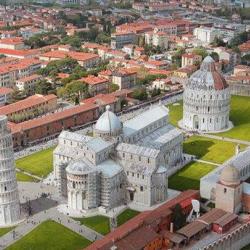Update of the Statement of Outstanding Universal Value

““Standing in a large green expanse, Piazza del Duomo houses a group of monuments known the world over. These four masterpieces of medieval architecture – the cathedral, the baptistry, the campanile (the 'Bell Tower', also known as the ‘Leaning Tower’) and the cemetery – had a great influence on monumental art in Italy from the 11th to the 14th century.”
In 2007, on the occasion of the thirty-first Conference of the World Heritage Committee, the requests for redefining the boundaries of the Site area (core area) and the identification of the buffer zone [1], were proposed, were both approved by the Committee [2].
Regarding the first aspect, considering research and studies on the visual axes after the registration of the Site in the WHL, Italy proposed to expand the inscribed area, including in it all three main visual axes that lead to the Square:
- The approach from the south along Via Santa Maria al Duomo.
- The western approach through the second door, opened in the 15th century by the Florentines, which changed the perception of the Square by moving the first view from the Cathedral to the new Palazzo dell'Arcivescovado, a symbol of new political power.
- The approach from the east, dating back to the nineteenth century, along a new road, Via Torelli, focused on the Bell Tower.
To encompass these three axes, the proposed extension includes a portion of Via Santa Maria, traced in the 11th century to frame the view of the apse and transept of the new Cathedral of the Square in front of the Archbishop's Palace, as well as a portion of the City walls in front of the Square and a part of the buildings that delimit the Square and part of Via Torelli (now Via Maffi). All main buildings, even within those within the proposed extension, are protected, for their artistic and historical interest, by Law 4/1994 or the Ronchey Law [3]. The decision of the WHC to accept the proposed proposal has resulted in an extension of the area from 7.57 to 8.87 hectares.
As regards the second proposal, we note that, at the time of registration of the Site in the WHL, no buffer zone was defined for the area. Therefore, Italy asked to identify the historic center of Pisa as a buffer zone, which extends mainly to the south and east of the area registered on an area of about 245 hectares already subject to a specific regulatory protection regime in compliance with national legislation. What was accomplished and achieved in 2007 was undoubtedly critical to the updating, in 2018, of the Declaration of Outstanding Universal Value of the Site in Piazza del Duomo. In fact, the premise for the reasons that led to the 2007 Decision lay in the fact that Italy believed that the original appointment, and subsequent registration of the Site in the WHL, were not sufficient to fully recognize the value of Piazza del Duomo and its particular composition, which results from precise artistic and ideological concepts. The original reasons for the application, in fact, focused exclusively on the four medieval monuments: Cathedral, Baptistery, Bell Tower and Camposanto. The update incorporates and embraces the concept of the organic interdependencies of the Site and the spatial composition that characterizes it as a unicum. Therefore, it is not only the individual monuments that contribute to the determination of the Site's Outstanding Universal Value, but also their mutual spatial relationship and their connection with the urban context of reference.
Notes:
- Advisory Board Evaluation (ICOMOS), 2007. Fonte: https://whc.unesco.org/en/list/395/documents/
- 31 COM 8B.61
- Repealed by D. Lgs.42/2004 “Codice dei Beni culturali e del paesaggio”.
